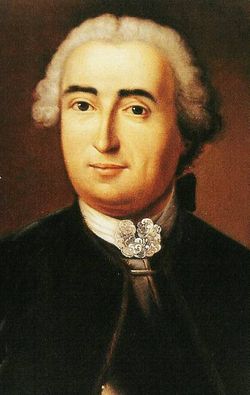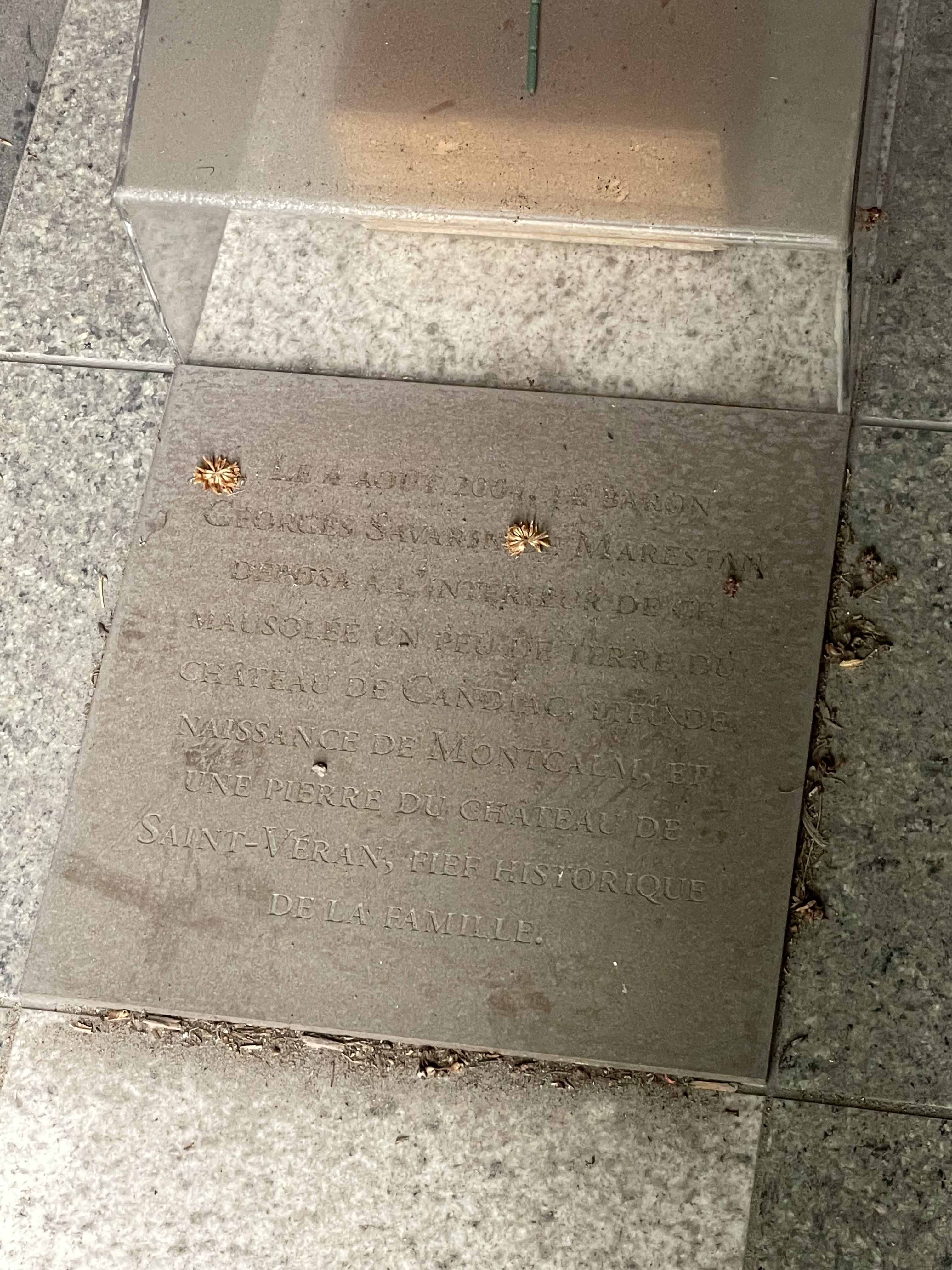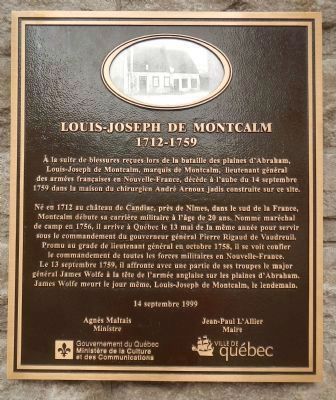A soldier at fifteen, he spent his leisure in camp reading Greek and German. He served successively at the sieges of Kehl and Philipsbourg during the 1733-1738 War of Polish Secession. He became a Knight of St. Louis in 1741 after a campaign in Bohemia, and was appointed Colonel of the Auxerrois Regiment in 1743. He received five wounds at the Battle of Piacenza during the War of the Austrian Succession.
In 1755 he succeeded the ill-fated General Jean Erdman, Baron Dieskau, in the command of the French army in Canada, under Governor Pierre de Rigaud, Marquis de Vaudreuil-Cavagnal. The dissonance of character between the two chiefs was to cause much friction during this trying period. Unlike his superior, he was quick in conception, fearless, generous and impulsive, self-reliant and decisive in action. Intendant François Bigot's unscrupulous dishonesty, the apathy of the French court for the "few arpents of snow", an impoverished colony, an ill-fed, ill-clad and badly provided army, all this enhanced his courage and faithfulness to duty.
The disproportion in numbers and resources between the belligerent forces rendered more arduous the problem to be solved. Yet it was only after a record of three brilliant victories that he was to end his glorious career on the Plains of Abraham.
First in order of time comes the capture of Chouaguen ( now Oswego), an undertaking wherein all the odds were against the besiegers. Overcoming all diffidence, Montcalm succeeded on August 14, 1756, thereby winning the region of Ontario to the domination of France, and with a few badly armed troops taking 1600 English prisoners, 5 flags, 100 guns, at the cost of only 30 killed and wounded.
He had another triumph with the capture of Fort William Henry, on August 9, 1757.
The last and greatest of his victories, shared by Lévis and Bourlamaque, was at Carillon (now Ticonderoga), a battle which was to result either in the salvation or destruction of New France. Although a first encounter, on 5 July, 1758, had proved disastrous to the French, the death of the valiant young Lord Howe, the real head of the English troops, deprived Abercromby of his chief support. On the 8th the onslaught of the entire Anglo-American army was rendered impossible by the earthworks and complicated barricade of felled trees protecting Fort Carillon; while a deadly fire decimated the assailants.
When the fray was over 2000 English soldiers lay killed or wounded, while the French losses were only 104 killed and 248 wounded; 3800 men had repulsed 15,000. After arresting the invasion by land, he had to face the attack of the naval forces. During the siege of Quebec by Wolfe, he and Lévis won a first victory at Montmorency Falls, with a loss of 450 to the English, on July 31, 1759.
But the final act was drawing nigh, which was to seal the fate of New France. On September 13, the enemy stealthily scaled the Heights of Abraham, and at early morn was ranged in battle. Thunderstruck by the unexpected tidings, he hurried from Beauport and arrayed his troops. Though about equal in numbers, they were doomed to defeat for several reasons, including surprise, hardship, privation, fatigue, and a disadvantageous position.
Both generals fell, Wolfe dying on the battle-field.
"Montcalm, still on horseback, was borne with the tide of fugitives towards the town. As he approached the walls a shot passed through his body. He kept his seat; two soldiers supported him, one on each side, and led his horse through the St. Louis Gate. On the open space within, among the excited crowd, were several women, drawn, no doubt, by eagerness to know the result of the fight. One of them recognized him, saw the streaming blood, and shrieked, "O mon Dieu! mon Dieu! le Marquis est tué!" "It's nothing, it's nothing," replied the death-stricken man; "don't be troubled for me, my good friends." Montcalm and Wolfe, Chapter XXVII by Francis Parkman
"When he was brought wounded from the field, he was placed in the house of the Surgeon Arnoux...He died peacefully at four o'clock on the morning of the 14th.
In the confusion of the time no workman could be found to make a coffin, and an old servant of the Ursulines, known as Bonhomme Michel, gathered a few boards and nailed them together so as to form a rough box. In it was laid the body of the dead soldier; and late in the evening of the same day he was carried to his rest. There was no tolling of bells or firing of cannon. The officers of the garrison followed the bier, and some of the populace, including women and children, joined the procession as it moved in dreary silence along the dusky street, shattered with cannon-ball and bomb, to the chapel of the Ursuline convent. Here a shell, bursting under the floor, had made a cavity which had been hollowed into a grave. Three priests of the Cathedral, several nuns, Ramesay with his officers, and a throng of townspeople were present at the rite. After the service and the chant, the body was lowered into the grave by the light of torches; and then, says the chronicle, "the tears and sobs burst forth. It seemed as if the last hope of the colony were buried with the remains of the General." In truth, the funeral of Montcalm was the funeral of New France." Montcalm and Wolfe, Chapter XXVIII, by Francis Parkman
This battle, considered in its results, was one of the greatest events of the eighteenth century. It saved Canada from the French Revolution and heralded the dawn of American Independence.
Montcalm was a brave and generous commander, a high-minded and disinterested patriot; a faithful Christian giving to God the glory of his victories.
His body was buried in the chapel of the Ursulines sisters until October 11, 2001, when he finally got the funeral he never had. On that day, in presence of the religious, civil and military authorities of Québec and France and thousands of Quebeckers he was transferred with all the due pomps to the Hôpital Général de Québec Cemetery. His mausoleum has been build just beside the graves of hundreds of his men and officers, including 17 of his fellow Knights of St.Louis, This sacred ground has become the Seven Years War Memorial.
A soldier at fifteen, he spent his leisure in camp reading Greek and German. He served successively at the sieges of Kehl and Philipsbourg during the 1733-1738 War of Polish Secession. He became a Knight of St. Louis in 1741 after a campaign in Bohemia, and was appointed Colonel of the Auxerrois Regiment in 1743. He received five wounds at the Battle of Piacenza during the War of the Austrian Succession.
In 1755 he succeeded the ill-fated General Jean Erdman, Baron Dieskau, in the command of the French army in Canada, under Governor Pierre de Rigaud, Marquis de Vaudreuil-Cavagnal. The dissonance of character between the two chiefs was to cause much friction during this trying period. Unlike his superior, he was quick in conception, fearless, generous and impulsive, self-reliant and decisive in action. Intendant François Bigot's unscrupulous dishonesty, the apathy of the French court for the "few arpents of snow", an impoverished colony, an ill-fed, ill-clad and badly provided army, all this enhanced his courage and faithfulness to duty.
The disproportion in numbers and resources between the belligerent forces rendered more arduous the problem to be solved. Yet it was only after a record of three brilliant victories that he was to end his glorious career on the Plains of Abraham.
First in order of time comes the capture of Chouaguen ( now Oswego), an undertaking wherein all the odds were against the besiegers. Overcoming all diffidence, Montcalm succeeded on August 14, 1756, thereby winning the region of Ontario to the domination of France, and with a few badly armed troops taking 1600 English prisoners, 5 flags, 100 guns, at the cost of only 30 killed and wounded.
He had another triumph with the capture of Fort William Henry, on August 9, 1757.
The last and greatest of his victories, shared by Lévis and Bourlamaque, was at Carillon (now Ticonderoga), a battle which was to result either in the salvation or destruction of New France. Although a first encounter, on 5 July, 1758, had proved disastrous to the French, the death of the valiant young Lord Howe, the real head of the English troops, deprived Abercromby of his chief support. On the 8th the onslaught of the entire Anglo-American army was rendered impossible by the earthworks and complicated barricade of felled trees protecting Fort Carillon; while a deadly fire decimated the assailants.
When the fray was over 2000 English soldiers lay killed or wounded, while the French losses were only 104 killed and 248 wounded; 3800 men had repulsed 15,000. After arresting the invasion by land, he had to face the attack of the naval forces. During the siege of Quebec by Wolfe, he and Lévis won a first victory at Montmorency Falls, with a loss of 450 to the English, on July 31, 1759.
But the final act was drawing nigh, which was to seal the fate of New France. On September 13, the enemy stealthily scaled the Heights of Abraham, and at early morn was ranged in battle. Thunderstruck by the unexpected tidings, he hurried from Beauport and arrayed his troops. Though about equal in numbers, they were doomed to defeat for several reasons, including surprise, hardship, privation, fatigue, and a disadvantageous position.
Both generals fell, Wolfe dying on the battle-field.
"Montcalm, still on horseback, was borne with the tide of fugitives towards the town. As he approached the walls a shot passed through his body. He kept his seat; two soldiers supported him, one on each side, and led his horse through the St. Louis Gate. On the open space within, among the excited crowd, were several women, drawn, no doubt, by eagerness to know the result of the fight. One of them recognized him, saw the streaming blood, and shrieked, "O mon Dieu! mon Dieu! le Marquis est tué!" "It's nothing, it's nothing," replied the death-stricken man; "don't be troubled for me, my good friends." Montcalm and Wolfe, Chapter XXVII by Francis Parkman
"When he was brought wounded from the field, he was placed in the house of the Surgeon Arnoux...He died peacefully at four o'clock on the morning of the 14th.
In the confusion of the time no workman could be found to make a coffin, and an old servant of the Ursulines, known as Bonhomme Michel, gathered a few boards and nailed them together so as to form a rough box. In it was laid the body of the dead soldier; and late in the evening of the same day he was carried to his rest. There was no tolling of bells or firing of cannon. The officers of the garrison followed the bier, and some of the populace, including women and children, joined the procession as it moved in dreary silence along the dusky street, shattered with cannon-ball and bomb, to the chapel of the Ursuline convent. Here a shell, bursting under the floor, had made a cavity which had been hollowed into a grave. Three priests of the Cathedral, several nuns, Ramesay with his officers, and a throng of townspeople were present at the rite. After the service and the chant, the body was lowered into the grave by the light of torches; and then, says the chronicle, "the tears and sobs burst forth. It seemed as if the last hope of the colony were buried with the remains of the General." In truth, the funeral of Montcalm was the funeral of New France." Montcalm and Wolfe, Chapter XXVIII, by Francis Parkman
This battle, considered in its results, was one of the greatest events of the eighteenth century. It saved Canada from the French Revolution and heralded the dawn of American Independence.
Montcalm was a brave and generous commander, a high-minded and disinterested patriot; a faithful Christian giving to God the glory of his victories.
His body was buried in the chapel of the Ursulines sisters until October 11, 2001, when he finally got the funeral he never had. On that day, in presence of the religious, civil and military authorities of Québec and France and thousands of Quebeckers he was transferred with all the due pomps to the Hôpital Général de Québec Cemetery. His mausoleum has been build just beside the graves of hundreds of his men and officers, including 17 of his fellow Knights of St.Louis, This sacred ground has become the Seven Years War Memorial.
Bio by: Guy Gagnon
Advertisement
See more Montcalm memorials in:
Explore more
Sponsored by Ancestry
Advertisement








